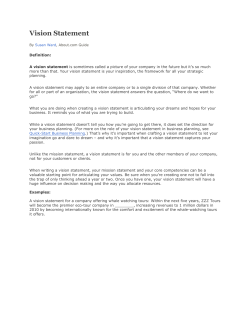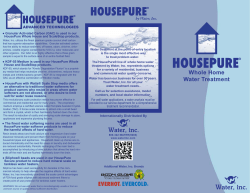
Document 200698
Canadian Rockhound: How to tell minerals apart Page 1 of 3 About Us | Contact Us | Services | Copyright Issues | News & Events | Junior | Resources | Clubs | Dealers | Classifieds | Links | Home Contents: Rocks & Minerals How to tell Minerals Apart By Marilyn Fraser z What are they? z Telling them Apart z Mineral Identifier z Classifying Rocks z The Rock Cycle z Igneous Rocks Between 2500 and 3000 minerals have been identified, but there are only 60 that you will come across in the field. They are identified by their various characteristics – colour, luster, streak and hardness are the obvious ones. Mohs Scale Minerals: z Metamorphic Rocks z Sedimentary Rocks Colour Geology of the Earth z Plate Tectonics z Geological Time Colour is an important key to identifying your specimen – just as its important to be able to tell an apple from a pear. 1 Talc z Natural Disasters Collections z Starting a Collection z Organizing Field Trips z Preparing z Using Maps Safety Tips z Safe Rockhounding z Code of Conduct Luster Another important thing to notice when identifying a mineral is the shine – known as luster – whether it looks like metal (metallic) or glass, like diamond or silky. Streak 2 Gypsum 3 Calcite The streak made by a mineral is often a different colour than the mineral itself. The streak is found by rubbing the mineral on an unglazed piece of ceramic tile. The colour of the streak is important in helping you identify the mineral. Clubs & Societies z Directory Back to Front Page Hardness 4 Fluorite Another important factor in knowing your rocks is the hardness. A common system of measuring hardness is the Mohs Scale. The scale runs fron the softest mineral, talc, as "Mohs 1" to the hardest mineral, diamond, as "Mohs 10". (The pictures to the right show what these minerals look like). The Mohs Scale: 1. 2. 3. 4. 5 Apatite Talc Gypsum Calcite Flourite http://epe.lac-bac.gc.ca/100/201/300/cdn_rockhound/1997-2000/junior_minprop.html 05/02/2006 Canadian Rockhound: How to tell minerals apart 5. 6. 7. 8. 9. 10. Apatite Feldspar Quartz Topaz Corundum Diamond In the beginning you can use four categories of hardness: z z z z Page 2 of 3 6 Orthoclase softer than 2.5 between 2.5 and 5.5 between 5.5 and 7 and harder than 7 Your fingernail has a hardness of 2.5. If you can scratch your mineral or rock with your fingernail, you know it is softer than 2.5. A pocket knife has a hardness of 5.5 and quartz has a hardness of 7. If you can scratch it with your pocket knife, you know it is softer than 5.5. These four tests – colour, luster, streak and hardness – will go a long way to help you identify the mineral you find. All the mineral field guide books around the world use these characteristics in describing minerals. 7 Quartz 8 Topaz Copyright ©1998 Marilyn Fraser E-mail: silver@tor.axxent.ca This article may not be copied, distributed or reprinted in any form without the author's permission. To contact the author, please use the e-mail address provided. If you are unable to contact the author, please contact the Canadian Rockhound. Authorized reprints must acknowledge the author, original source and the Canadian Rockhound, and include the website URL address of the Canadian Rockhound. 9 Corundum 10 Diamond Images of Mohs scale minerals are Copyright ©1995-1996 by Amethyst Galleries, Inc., and are used here for educational purposes only. Top of Page http://epe.lac-bac.gc.ca/100/201/300/cdn_rockhound/1997-2000/junior_minprop.html 05/02/2006 Canadian Rockhound: How to tell minerals apart Page 3 of 3 Copyright © 2000 Canadian Rockhound Webpage design by H. J. Schmid & Associates, Inc. Winnipeg, Manitoba, Canada Magazine Issues | News & Events | Junior Rockhound | Resources Clubs | Dealers | Classifieds | Web Links | Home http://epe.lac-bac.gc.ca/100/201/300/cdn_rockhound/1997-2000/junior_minprop.html 05/02/2006
© Copyright 2025





















